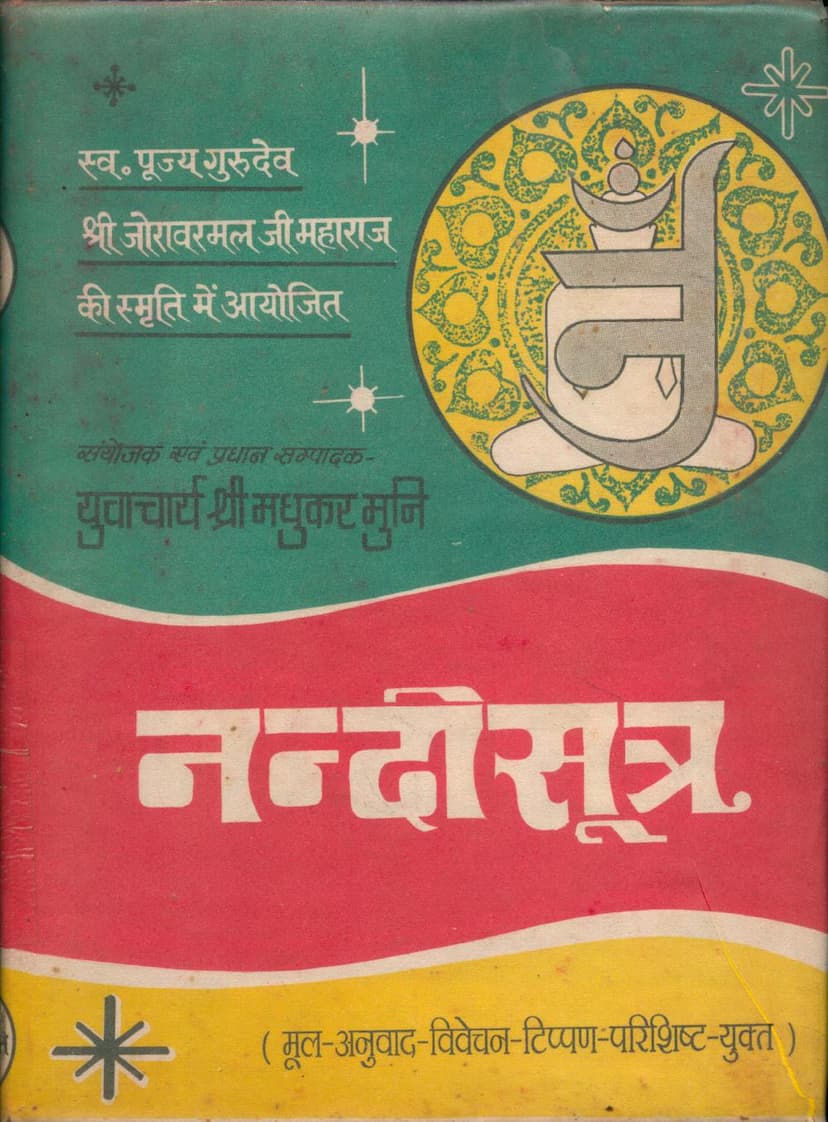Agam 31 Chulika 01 Nandi Sutra Stahanakvasi
Added to library: September 1, 2025

Summary
This Jain text, Nandi Sutra, is a commentary and translation of a foundational Jain scripture, originally authored by Devavachak. The edition summarized here is published by Agam Prakashan Samiti and was compiled under the guidance of Yuvaacharya Shri Madhukar Muni. It is dedicated to the memory of Param Shradhey Gurudev Shri Joravarmalji Maharaj.
The Nandi Sutra, considered highly auspicious in Jain tradition, is presented with its original text, a Hindi translation, detailed explanations (vivechan), notes, and appendices. The work was translated and annotated by Sadhvi Umravkunwar 'Archana' and edited by Kamala Jain 'Jiji'.
Key aspects and content highlighted in the provided text include:
- Dedication and Commemoration: The book is published in remembrance of Guru Shri Joravarmalji Maharaj, emphasizing the transmission of knowledge and spiritual heritage.
- Editorial and Publishing Details: The publication is part of the Jinagam Granthamala series, with details about the convener, editor, publishers, printers, and publication date (Vir Nirvana Samvat 2526 / Vikram Samvat 2056 / January 2000).
- Inspirational and Foundational Content: The text begins with a Mangalacharan (auspicious invocation) of the Mahamantra "Namo Arihantanam" and other verses, setting a spiritual tone.
- The Nandi Sutra's Significance: The book is recognized as a highly auspicious text, recited by monks, nuns, and followers alike. It is intended for both extensive study and daily recitation, aiming for a balanced, informative, and accessible presentation.
- Thematic Overview (from the Table of Contents and Preface): The Nandi Sutra primarily focuses on the concept of Jnana (Knowledge) in Jainism. It systematically analyzes:
- Praise of Arihants and Lord Mahavir: Including hymns and eulogies.
- Praise of the Sangha: The Jain community is praised through various metaphors like a city, chariot, lotus, moon, sun, ocean, and the Meru mountain, highlighting its virtues like conduct, penance, knowledge, and spiritual fortitude.
- The Five Types of Knowledge (Pancha Jnana): This is a central theme. The text details:
- Abhinibodhika Jnana (Mati Jnana): Sensory and mental knowledge, further categorized into types of perception and listeners (shrota) with illustrative examples.
- Shruta Jnana: Knowledge gained from scriptures and learned discourse, analyzed extensively based on its nature (akshara, anakshara, samyaka, mithya, etc.) and its reliance on prior mati knowledge.
- Avadhi Jnana: Clairvoyant knowledge, described in terms of its types (bhavapratyayi, kshayopashami), its extent (jaghanya, utkrsta, madhyama), and its continuity (anugamika, ananugamika, pratipati, apratipati).
- Manahparyaya Jnana: Telepathic knowledge of others' thoughts, discussed in terms of its prerequisites (human birth, karma-bhumi, number of years of life, perception, conduct) and its types (Rijumati, Vipulamati).
- Kevala Jnana: Omniscient knowledge, the ultimate state, described in terms of its manifestation in embodied (sayogi) and liberated (ayogi) souls, and its attributes.
- Classification of Knowledge: Knowledge is broadly categorized into pratyaksha (direct) and paroksha (indirect), with further sub-classifications.
- Detailed analysis of Mati Jnana: This includes its four stages: Avagraha (comprehension), Iha (investigation), Avaya (determinate knowledge), and Dharana (retention). Numerous illustrative examples and anecdotes (like those of Rohak, Abhaykumar, etc.) are used to explain these concepts and demonstrate the power of intelligence and quick wit (Ouatpattiki Buddhi).
- Detailed exposition of Shruta Jnana: This covers its various classifications, including akshara (articulate) and anakshara (inarticulate) aspects, and its connection to different types of perception and conduct.
- The Twelve Angas (Primary Scriptures): The text lists and provides brief overviews of all twelve Angas of the Jain canon (Achara, Sutrakruti, Sthana, Samavaya, Vyakhyaprajnapti/Bhagavati, Jnatadharmakatha, Upasakadasha, Antakriddasha, Anuttaraupapati, Prashna-vyakarana, Vipaka, and Drishtivada), outlining their respective contents and significance.
- The Importance of Scripture Study: The text stresses the benefits of studying scriptures, including overcoming ignorance, gaining spiritual insight, and achieving liberation.
- The Concept of Anadhyayana (Unsuitable Times for Study): A significant portion is dedicated to the times and circumstances when scriptural study is discouraged, drawing parallels from Vedic traditions and outlining specific celestial and physical phenomena.
- Scholarly Contributions: The preface acknowledges the extensive effort and scholarly contribution from various individuals and organizations, including the editorial board and patrons.
- Historical and Philosophical Context: The "Prakarana" (Introduction) by Vijay Muni Shastri provides a valuable historical and philosophical backdrop, discussing the Vedic, Buddhist, and Jain traditions, and the evolution of Jain philosophy as found in the Agamas.
In essence, this edition of the Nandi Sutra serves as a comprehensive guide to the study of Jain scriptures, particularly focusing on the epistemology and the nature of knowledge within the Jain philosophical framework, while also celebrating the legacy of spiritual leaders.